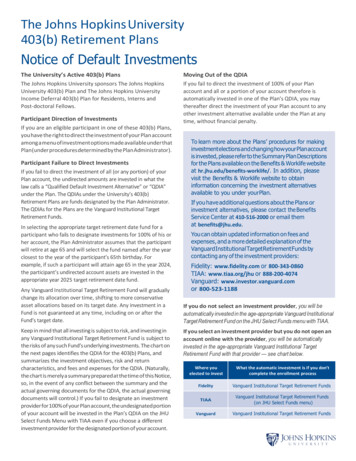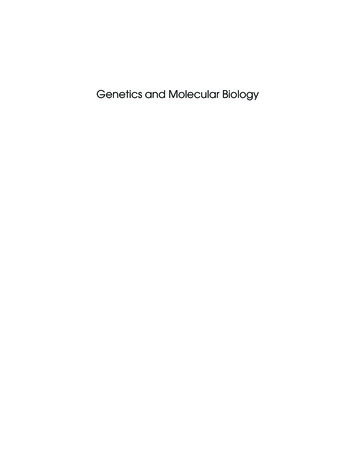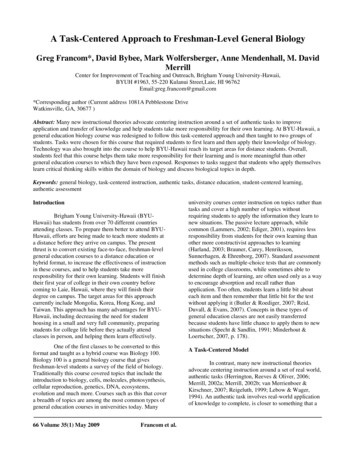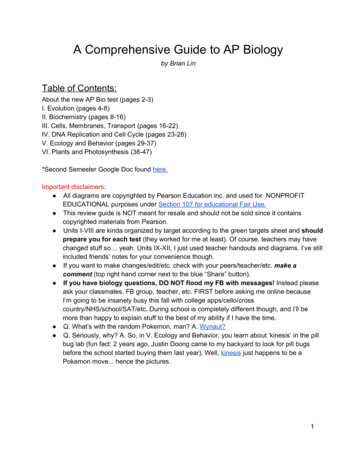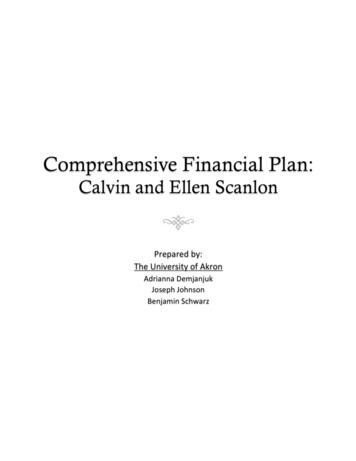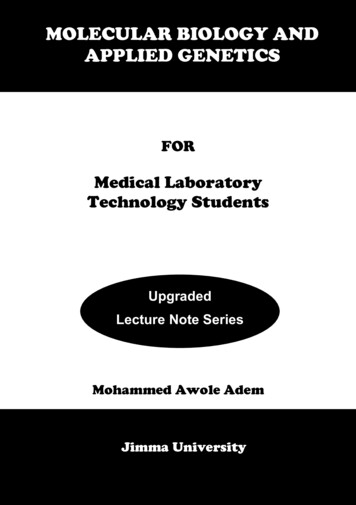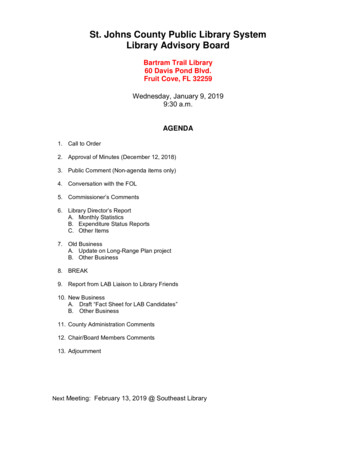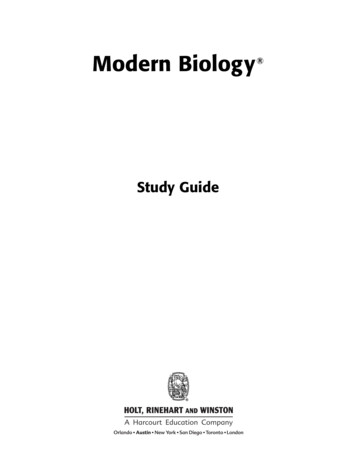
Transcription
Modern Biology Study Guide
About the Modern Biology Study GuideThe Section Review worksheets can be used in a number of ways to guide you throughyour textbook: as a pre-reading guide to each section, as a review of the chapter’s mainconcepts after you read each section, or even as test preparation for your biology exams.No matter how your teacher chooses to use these worksheets, the Modern Biology StudyGuide will help you succeed in your study of biology.In each Section Review worksheet, you will encounter four types of exercises:Vocabulary Review exercises help you to review important terms in each section.Multiple Choice questions test your understanding of important concepts and termsintroduced in each section.Short Answer (with Critical Thinking) questions help you to synthesize and writeyour own conclusions using information in the section.Structures and Functions questions provide opportunities to label major structuresand processes or to interpret data or figures in order to examine the section materialin a larger context.Copyright by Holt, Rinehart and WinstonAll rights reserved. No part of this publication may be reproduced or transmitted in any form or byany means, electronic or mechanical, including photocopy, recording, or any information storage andretrieval system, without permission in writing from the publisher.Teachers using MODERN BIOLOGY may photocopy blackline masters in complete pages in sufficientquantities for classroom use only and not for resale.HOLT, MODERN BIOLOGY, and the “Owl Design” are trademarks licensed to Holt, Rinehartand Winston, registered in the United States of America and/or other jurisdictions.Printed in the United States of AmericaISBN 0-03-036718-21 2 3 4 5 686208 07 06 05 04
CONTENTSChapter 1: The Science of LifeSection 1-1 ReviewSection 1-2 ReviewSection 1-3 ReviewSection 1-4 ReviewThe World of Biology. . . . . . . . . . . . . . . . . . . . . . . 1Themes in Biology . . . . . . . . . . . . . . . . . . . . . . . . . 3The Study of Biology . . . . . . . . . . . . . . . . . . . . . . . 5Tools and Techniques . . . . . . . . . . . . . . . . . . . . . . 7Chapter 2: Chemistry of LifeSection 2-1 ReviewSection 2-2 ReviewSection 2-3 ReviewComposition of Matter . . . . . . . . . . . . . . . . . . . . . 9Energy. . . . . . . . . . . . . . . . . . . . . . . . . . . . . . . . . . 11Water and Solutions. . . . . . . . . . . . . . . . . . . . . . . 13Chapter 3: BiochemistrySection 3-1 ReviewSection 3-2 ReviewCarbon Compounds. . . . . . . . . . . . . . . . . . . . . . . 15Molecules of Life . . . . . . . . . . . . . . . . . . . . . . . . . 17Chapter 4: Cell Structure and FunctionSection 4-1 ReviewSection 4-2 ReviewSection 4-3 ReviewSection 4-4 ReviewThe History of Cell Biology . . . . . . . . . . . . . . . . . 19Introduction to Cells . . . . . . . . . . . . . . . . . . . . . . 21Cell Organelles and Features. . . . . . . . . . . . . . . . 23Unique Features of Plant Cells . . . . . . . . . . . . . . 25Chapter 5: Homeostasis and Cell TransportSection 5-1 ReviewSection 5-2 ReviewPassive Transport . . . . . . . . . . . . . . . . . . . . . . . . 27Active Transport . . . . . . . . . . . . . . . . . . . . . . . . . 29Chapter 6: PhotosynthesisSection 6-1 ReviewSection 6-2 ReviewThe Light Reactions . . . . . . . . . . . . . . . . . . . . . . 31The Calvin Cycle . . . . . . . . . . . . . . . . . . . . . . . . . 33Chapter 7: Cellular RespirationSection 7-1 ReviewSection 7-2 ReviewGlycolysis and Fermentation. . . . . . . . . . . . . . . . 35Aerobic Respiration . . . . . . . . . . . . . . . . . . . . . . . 37Chapter 8: Cell ReproductionSection 8-1 ReviewSection 8-2 ReviewSection 8-3 ReviewChromosomes . . . . . . . . . . . . . . . . . . . . . . . . . . . 39Cell Division . . . . . . . . . . . . . . . . . . . . . . . . . . . . . 41Meiosis . . . . . . . . . . . . . . . . . . . . . . . . . . . . . . . . . 43Chapter 9: Fundamentals of GeneticsSection 9-1 ReviewSection 9-2 ReviewMendel’s Legacy. . . . . . . . . . . . . . . . . . . . . . . . . . 45Genetic Crosses . . . . . . . . . . . . . . . . . . . . . . . . . . 47Modern Biology Study Guideiii
Chapter 10: DNA, RNA, and Protein SynthesisSection 10-1 ReviewSection 10-2 ReviewSection 10-3 ReviewSection 10-4 ReviewDiscovery of DNA. . . . . . . . . . . . . . . . . . . . . . . . . 49DNA Structure . . . . . . . . . . . . . . . . . . . . . . . . . . . 51DNA Replication. . . . . . . . . . . . . . . . . . . . . . . . . . 53Protein Synthesis . . . . . . . . . . . . . . . . . . . . . . . . . 55Chapter 11: Gene ExpressionSection 11-1 ReviewSection 11-2 ReviewControl of Gene Expression. . . . . . . . . . . . . . . . . 57Gene Expression in Developmentand Cell Division . . . . . . . . . . . . . . . . . . . . . . . . . 59Chapter 12: Inheritance Patterns and Human GeneticsSection 12-1 ReviewSection 12-2 ReviewChromosomes and Inheritance . . . . . . . . . . . . . . 61Human Genetics . . . . . . . . . . . . . . . . . . . . . . . . . . 63Chapter 13: Gene TechnologySection 13-1 ReviewSection 13-2 ReviewSection 13-3 ReviewDNA Technology . . . . . . . . . . . . . . . . . . . . . . . . . 65The Human Genome Project . . . . . . . . . . . . . . . . 67Genetic Engineering. . . . . . . . . . . . . . . . . . . . . . . 69Chapter 14: History of LifeSection 14-1 ReviewSection 14-2 ReviewSection 14-3 ReviewBiogenesis . . . . . . . . . . . . . . . . . . . . . . . . . . . . . . 71Earth’s History . . . . . . . . . . . . . . . . . . . . . . . . . . . 73The First Life-Forms. . . . . . . . . . . . . . . . . . . . . . . 75Chapter 15: Theory of EvolutionSection 15-1 ReviewSection 15-2 ReviewSection 15-3 ReviewHistory of Evolutionary Thought . . . . . . . . . . . . 77Evidence of Evolution . . . . . . . . . . . . . . . . . . . . . 79Evolution in Action . . . . . . . . . . . . . . . . . . . . . . . 81Chapter 16: Population Genetics and SpeciationSection 16-1 ReviewSection 16-2 ReviewSection 16-3 ReviewGenetic Equilibrium . . . . . . . . . . . . . . . . . . . . . . . 83Disruption of Genetic Equilibrium . . . . . . . . . . . 85Formation of Species . . . . . . . . . . . . . . . . . . . . . . 87Chapter 17: Classification of OrganismsSection 17-1 ReviewSection 17-2 ReviewSection 17-3 ReviewBiodiversity . . . . . . . . . . . . . . . . . . . . . . . . . . . . . 89Systematics . . . . . . . . . . . . . . . . . . . . . . . . . . . . . 91Modern Classification . . . . . . . . . . . . . . . . . . . . . 93Chapter 18: Introduction to EcologySection 18-1 ReviewSection 18-2 ReviewSection 18-3 ReviewSection 18-4 ReviewivModern Biology Study GuideIntroduction to Ecology. . . . . . . . . . . . . . . . . . . . 95Ecology of Organisms . . . . . . . . . . . . . . . . . . . . . 97Energy Transfer . . . . . . . . . . . . . . . . . . . . . . . . . . 99Ecosystem Recycling . . . . . . . . . . . . . . . . . . . . . 101
Chapter 19: PopulationsSection 19-1 ReviewSection 19-2 ReviewSection 19-3 ReviewUnderstanding Populations. . . . . . . . . . . . . . . . 103Measuring Populations . . . . . . . . . . . . . . . . . . . 105Human Population Growth . . . . . . . . . . . . . . . . 107Chapter 20: Community EcologySection 20-1 ReviewSection 20-2 ReviewSpecies Interactions. . . . . . . . . . . . . . . . . . . . . . 109Patterns in Communities . . . . . . . . . . . . . . . . . . 111Chapter 21: EcosystemsSection 21-1 ReviewSection 21-2 ReviewTerrestrial Biomes . . . . . . . . . . . . . . . . . . . . . . . 113Aquatic Ecosystems. . . . . . . . . . . . . . . . . . . . . . 115Chapter 22: Humans and the EnvironmentSection 22-1 ReviewSection 22-2 ReviewSection 22-3 ReviewAn Interconnected Planet . . . . . . . . . . . . . . . . . 117Environmental Issues. . . . . . . . . . . . . . . . . . . . . 119Environmental Solutions . . . . . . . . . . . . . . . . . . 121Chapter 23: BacteriaSection 23-1 ReviewSection 23-2 ReviewSection 23-3 ReviewProkaryotes . . . . . . . . . . . . . . . . . . . . . . . . . . . . 123Biology of Prokaryotes . . . . . . . . . . . . . . . . . . . 125Bacteria and Humans. . . . . . . . . . . . . . . . . . . . . 127Chapter 24: VirusesSection 24-1 ReviewSection 24-2 ReviewViral Structure and Replication. . . . . . . . . . . . . 129Viral Diseases . . . . . . . . . . . . . . . . . . . . . . . . . . . 131Chapter 25: ProtistsSection 25-1 ReviewSection 25-2 ReviewSection 25-3 ReviewSection 25-4 ReviewCharacteristics of Protists. . . . . . . . . . . . . . . . . 133Animal-like Protists . . . . . . . . . . . . . . . . . . . . . . 135Plantlike and Funguslike Protists . . . . . . . . . . . 137Protists and Humans . . . . . . . . . . . . . . . . . . . . . 139Chapter 26: FungiSection 26-1 ReviewSection 26-2 ReviewSection 26-3 ReviewOverview of Fungi . . . . . . . . . . . . . . . . . . . . . . . 141Classification of Fungi . . . . . . . . . . . . . . . . . . . . 143Fungi and Humans . . . . . . . . . . . . . . . . . . . . . . . 145Chapter 27: The Importance of PlantsSection 27-1 ReviewSection 27-2 ReviewPlants and People . . . . . . . . . . . . . . . . . . . . . . . 147Plants and the Environment . . . . . . . . . . . . . . . 149Chapter 28: Plant Evolution and ClassificationSection 28-1 ReviewSection 28-2 ReviewSection 28-3 ReviewOverview of Plants. . . . . . . . . . . . . . . . . . . . . . . 151Nonvascular Plants . . . . . . . . . . . . . . . . . . . . . . 153Vascular Plants. . . . . . . . . . . . . . . . . . . . . . . . . . 155Modern Biology Study Guidev
Chapter 29: Plant Structure and FunctionSection 29-1 ReviewSection 29-2 ReviewSection 29-3 ReviewSection 29-4 ReviewPlant Cells and Tissues . . . . . . . . . . . . . . . . . . . 157Roots. . . . . . . . . . . . . . . . . . . . . . . . . . . . . . . . . . 159Stems . . . . . . . . . . . . . . . . . . . . . . . . . . . . . . . . . 161Leaves. . . . . . . . . . . . . . . . . . . . . . . . . . . . . . . . . 163Chapter 30: Plant ReproductionSection 30-1 ReviewSection 30-2 ReviewSection 30-3 ReviewPlant Life Cycles. . . . . . . . . . . . . . . . . . . . . . . . . 165Sexual Reproduction in Flowering Plants. . . . . 167Dispersal and Propagation . . . . . . . . . . . . . . . . 169Chapter 31: Plant ResponsesSection 31-1 ReviewSection 31-2 ReviewSection 31-3 ReviewPlant Hormones . . . . . . . . . . . . . . . . . . . . . . . . . 171Plant Movements . . . . . . . . . . . . . . . . . . . . . . . . 173Seasonal Responses. . . . . . . . . . . . . . . . . . . . . . 175Chapter 32: Introduction to AnimalsSection 32-1 ReviewSection 32-2 ReviewSection 32-3 ReviewThe Nature of Animals. . . . . . . . . . . . . . . . . . . . 177Invertebrates and Vertebrates . . . . . . . . . . . . . 179Fertilization and Development . . . . . . . . . . . . . 181Chapter 33: Sponges, Cnidarians, and CtenophoresSection 33-1 ReviewSection 33-2 ReviewPorifera . . . . . . . . . . . . . . . . . . . . . . . . . . . . . . . . 183Cnidaria and Ctenophora . . . . . . . . . . . . . . . . . 185Chapter 34: Flatworms, Roundworms, and RotifersSection 34-1 ReviewSection 34-2 ReviewPlatyhelminthes . . . . . . . . . . . . . . . . . . . . . . . . . 187Nematoda and Rotifera . . . . . . . . . . . . . . . . . . . 189Chapter 35: Mollusks and AnnelidsSection 35-1 ReviewSection 35-2 ReviewMollusca . . . . . . . . . . . . . . . . . . . . . . . . . . . . . . . 191Annelida . . . . . . . . . . . . . . . . . . . . . . . . . . . . . . . 193Chapter 36: ArthropodsSection 36-1 ReviewSection 36-2 ReviewSection 36-3 ReviewPhylum Arthropoda . . . . . . . . . . . . . . . . . . . . . . 195Subphylum Crustacea . . . . . . . . . . . . . . . . . . . . 197Subphyla Chelicerata and Myriapoda . . . . . . . 199Chapter 37: InsectsSection 37-1 ReviewSection 37-2 ReviewThe Insect World . . . . . . . . . . . . . . . . . . . . . . . . 201Insect Behavior . . . . . . . . . . . . . . . . . . . . . . . . . 203Chapter 38: Echinoderms and Invertebrate ChordatesSection 38-1 ReviewSection 38-2 ReviewviModern Biology Study GuideEchinoderms . . . . . . . . . . . . . . . . . . . . . . . . . . . 205Invertebrate Chordates . . . . . . . . . . . . . . . . . . . 207
Chapter 39: FishesSection 39-1 ReviewSection 39-2 ReviewSection 39-3 ReviewIntroduction to Vertebrates. . . . . . . . . . . . . . . . 209Jawless and Cartilaginous Fishes . . . . . . . . . . . 211Bony Fishes . . . . . . . . . . . . . . . . . . . . . . . . . . . . 213Chapter 40: AmphibiansSection 40-1 ReviewSection 40-2 ReviewSection 40-3 ReviewOrigin and Evolution of Amphibians . . . . . . . . 215Characteristics of Amphibians . . . . . . . . . . . . . 217Reproduction in Amphibians . . . . . . . . . . . . . . 219Chapter 41: ReptilesSection 41-1 ReviewSection 41-2 ReviewSection 41-3 ReviewOrigin and Evolution of Reptiles . . . . . . . . . . . . 221Characteristics of Reptiles . . . . . . . . . . . . . . . . 223Modern Reptiles. . . . . . . . . . . . . . . . . . . . . . . . . 225Chapter 42: BirdsSection 42-1 ReviewSection 42-2 ReviewSection 42-3 ReviewOrigin and Evolution of Birds . . . . . . . . . . . . . . 227Characteristics of Birds . . . . . . . . . . . . . . . . . . . 229Classification . . . . . . . . . . . . . . . . . . . . . . . . . . . 231Chapter 43: MammalsSection 43-1 ReviewSection 43-2 ReviewSection 43-3 ReviewSection 43-4 ReviewOrigin and Evolution of Mammals . . . . . . . . . . 233Characteristics of Mammals . . . . . . . . . . . . . . . 235Diversity of Mammals . . . . . . . . . . . . . . . . . . . . 237Primates and Human Origins . . . . . . . . . . . . . . 239Chapter 44: Animal BehaviorSection 44-1 ReviewSection 44-2 ReviewDevelopment of Behavior . . . . . . . . . . . . . . . . . 241Types of Animal Behavior . . . . . . . . . . . . . . . . . 243Chapter 45: Skeletal, Muscular, and Integumentary SystemsSection 45-1 ReviewSection 45-2 ReviewSection 45-3 ReviewSection 45-4 ReviewThe Human Body Plan . . . . . . . . . . . . . . . . . . . . 245Skeletal System . . . . . . . . . . . . . . . . . . . . . . . . . 247Muscular System . . . . . . . . . . . . . . . . . . . . . . . . 249Integumentary System. . . . . . . . . . . . . . . . . . . . 251Chapter 46: Circulatory and Respiratory SystemsSection 46-1 ReviewSection 46-2 ReviewSection 46-3 ReviewThe Circulatory System . . . . . . . . . . . . . . . . . . . 253Blood. . . . . . . . . . . . . . . . . . . . . . . . . . . . . . . . . . 255The Respiratory System . . . . . . . . . . . . . . . . . . 257Chapter 47: The Body’s Defense SystemsSection 47-1 ReviewSection 47-2 ReviewSection 47-3 ReviewNonspecific Defenses. . . . . . . . . . . . . . . . . . . . . 259Specific Defenses: The Immune System . . . . . . 261HIV and AIDS . . . . . . . . . . . . . . . . . . . . . . . . . . . 263Modern Biology Study Guidevii
Chapter 48: Digestive and Excretory SystemsSection 48-1 ReviewSection 48-2 ReviewSection 48-3 ReviewNutrients. . . . . . . . . . . . . . . . . . . . . . . . . . . . . . . 265Digestive System . . . . . . . . . . . . . . . . . . . . . . . . 267Urinary System. . . . . . . . . . . . . . . . . . . . . . . . . . 269Chapter 49: Nervous System and Sense OrgansSection 49-1 ReviewSection 49-2 ReviewSection 49-3 ReviewSection 49-4 ReviewNeurons and Nerve Impulses . . . . . . . . . . . . . . 271Structure of the Nervous System . . . . . . . . . . . 273Sensory Systems . . . . . . . . . . . . . . . . . . . . . . . . 275Drugs and the Nervous System. . . . . . . . . . . . . 277Chapter 50: Endocrine SystemSection 50-1 ReviewSection 50-2 ReviewHormones . . . . . . . . . . . . . . . . . . . . . . . . . . . . . . 279Endocrine Glands. . . . . . . . . . . . . . . . . . . . . . . . 281Chapter 51: Reproductive SystemSection 51-1 ReviewSection 51-2 ReviewSection 51-3 ReviewviiiModern Biology Study GuideMale Reproductive System . . . . . . . . . . . . . . . . 283Female Reproductive System . . . . . . . . . . . . . . 285Gestation . . . . . . . . . . . . . . . . . . . . . . . . . . . . . . 287
NameClassDateSEC T I O N 1 - 1 R E VIEWT HE W ORLD OF B IOLOGYVOCABULARY REVIEW Define the following terms.1. development2. reproduction3. organ4. tissueMULTIPLE CHOICE Write the correct letter in the blank.Copyright by Holt, Rinehart and Winston. All rights reserved.1. Biology is the study ofa. animals.b. plants and animals.c. all living things.d. energy transfer.2. A short segment of DNA that contains instructions for the development of a single trait ofan organism is known as aa. DNA loop.b. gene.c. library.d. membrane.3. As the cells in a multicellular organism multiply, they become specialized for differentfunctions in a process calleda. sexual reproduction.b. descent with modification.c. photosynthesis.d. cell differentiation.4. Homeostasis refers to thea.b.c.d.organization of cellular structures.stable level of internal conditions in organisms.organized structure of crystals.destruction of tropical rain forests.5. Photosynthesis is part of a plant’sa. metabolism.b. homeostasis.c. development.d. response to stimuli.Modern Biology Study Guide1
NameClassDateSHORT ANSWER Answer the questions in the space provided.1. Explain why the cell is called the basic unit of life.2. Give a specific example of homeostasis.3. Why is it important to study biology?4. Contrast the reproduction of bacteria with that of frogs.5. Critical Thinking The organization of a rock is much simpler than that of living things.By what other criteria can a rock be distinguished from living things?2Section 1-1 ReviewCopyright by Holt, Rinehart and Winston. All rights reserved.STRUCTURES AND FUNCTIONS Explain how the drawing below illustrates thecharacteristics of life.
NameClassDateSEC T I O N 1 - 2 R E VIEWT HEMES IN B IOLOGYVOCABULARY REVIEW Distinguish between the terms in each of the following groupsof terms.1. domain, kingdom2. diversity of life, unity of life3. adaptations, evolution4. ecosystem, ecologyMULTIPLE CHOICE Write the correct letter in the blank.Copyright by Holt, Rinehart and Winston. All rights reserved.1. A “tree of life” explainsa.b.c.d.how organisms are related to each other.how organisms differ from each other.the lineages of various organisms.All of the above2. Which of the following is NOT an important unifying theme in biology?a.b.c.d.the diversity and unity of lifethe relationship between organisms and societythe interdependence of living organismsthe evolution of life3. An example of a domain isa. Animalia.b. Protista.c. Fungi.d. Eukarya.4. A trait that improves an individual’s ability to survive and reproduce is a(n)a. mutation.b. natural selectionc. adaptation.d. domain.5. Which of the following statements is true?a.b.c.d.Destruction of rain forests has no effect on living things.Destruction of rain forests increases the rate of evolution of rainforest organisms.Humans have had no impact on the world’s environment.Humans have had a large impact on the world’s environment.Modern Biology Study Guide3
NameClassDateSHORT ANSWER Answer the questions in the space provided.1. Give an example of how two organisms are interdependent.2. Why must an adaptation be inheritable if it is to cause a population to evolve?3. What is natural selection?4. If two organisms share the same kingdom, must they also share the same domain? Explain.5. Critical Thinking A female frog has a genetic trait that prevents it from producing eggs. Howlikely is it that this trait will spread through the frog population? Explain your answer.STRUCTURES AND FUNCTIONS Briefly describe the interactions among the panther, thedeer, and the grass in the drawing below.Copyright by Holt, Rinehart and Winston. All rights reserved.4Section 1-2 Review
NameClassDateSEC T I O N 1 - 3 R E VIEWT HE S TUDY OF B IOLOGYVOCABULARY REVIEW Define the following terms.1. prediction2. control group3. dependent variable4. independent variableCopyright by Holt, Rinehart and Winston. All rights reserved.5. theoryMULTIPLE CHOICE Write the correct letter in the blank.1. A field biologist who studies the behavior of birds in a rain forest most likely collectsdata througha. experimenting.b. modeling.c. observing.d. inferring.c. observing.d. predicting.2. Constructing a graph is an example ofa. measuring.b. organizing data.3. Of the following steps in a scientific investigation, the last to be done is usuallya. experimenting.b. observing.c. producing a model.d. hypothesizing.4. A statement that explains observations and can be tested is calleda. a hypothesis.b. an inference.c. a theory.d. a model.5. A visual, verbal, or mathematical explanation that is supported by data is calleda. a hypothesis.b. an inference.c. a theory.d. a model.Modern Biology Study Guide5
NameClassDateSHORT ANSWER Answer the questions in the space provided.1. What are quantitative data? Give two examples of quantitative data.2. What is an advantage of a peer review of a scientific paper?3. How are a hypothesis, a prediction, and an experiment related?4. What are some of the things scientists might do to analyze data?5. Critical Thinking A scientist wanted to study the effect of a drug on the blood pressure of rats.She set up an experiment in which the experimental group consisted of rats that were injectedwith a salt solution containing the drug. What should the control group have consisted of?STRUCTURES AND FUNCTIONS Examine the drawing of the owl. In each space below,provide an observation that would support the inference given or provide an inferencethat could be derived from the observation given.ObservationsInferencesOwls live in trees.Owls feed on mice.Owls kill prey withtheir talons.The owl has wings.Both of the owl’seyes face forward.It is night.6Section 1-3 ReviewCopyright by Holt, Rinehart and Winston. All rights reserved.What were the dependent and independent variables in her experiment?
NameClassDateSEC T I O N 1 - 4 R E VIEWT OOLS AND T ECHNIQUESVOCABULARY REVIEW Circle the term that does not belong in each of the followinggroups, and briefly explain why it does not belong.1. compound light, transmission electron, light electron, scanning electron2. base unit, stage, nosepiece, objective lens3. magnification, power of magnification, resolution, mass density4. second, minute, meter, kilogramCopyright by Holt, Rinehart and Winston. All rights reserved.5. meter, square meter, cubic meter, kilogram per cubic meterMULTIPLE CHOICE Write the correct letter in the blank.1. The ability of a microscope to show details clearly is calleda. enlargement.b. magnification.c. reduction.d. resolution.2. One limitation of the scanning electron microscope is that it cannot be used toa.b.c.d.examine specimens smaller than cells.view living specimens.produce an enlarged image of a specimen.produce an image of the surface of a specimen.3. A microscope with a 10 ocular lens and a 25 objective lens has a total power of magnification equal toa. 2.5 .b. 35 .c. 250 .d. 2,500 .c. hour.d. day.4. The SI base unit for time is thea. second.b. minute.5. The SI prefix that represents 1,000 times the base unit isa. deci.b. centi.c. kilo.d. micro.Modern Biology Study Guide7
NameClassDateSHORT ANSWER Answer the questions in the space provided.1. Arrange the following parts in the order that matches the light path through a light microscope:specimen, ocular lens, objective lens, light source.2. What are the maximum magnifications of the LM, TEM, and SEM?3. Write the abbreviation for each of the following units: meter, kilometer, centimeter, millimeter,micrometer. What is the mathematical relationship between these units?4. Critical Thinking A group of scientists want to determine whether the bacteria they are studying have viruses inside them. Which type of microscope should they use? Explain your answer.abcde8Section 1-4 ReviewCopyright by Holt, Rinehart and Winston. All rights reserved.STRUCTURES AND FUNCTIONS Label each part of the figure in the spaces provided.
NameClassDateSEC T I O N 2 - 1 R E VIEWC OMPOSITION OF M ATTERVOCABULARY REVIEW Define the following terms.1. atom2. neutron3. compound4. covalent bondCopyright by Holt, Rinehart and Winston. All rights reserved.5. ionMULTIPLE CHOICE Write the correct letter in the blank.1. The atomic number of carbon is 6. Therefore, the number of protons in a carbon atom equalsa. 3.b. 6.c. 7.d. 12.2. One of the kinds of particles found in the nucleus of an atom is thea. proton.b. electron.c. ion.d. boron.3. The maximum number of electrons that can be held in the orbitals in an atom’s secondenergy level isa. 2.b. 4.c. 6.d. 8.4. Of the following elements, the one that is most likely to form ionic bonds isa. hydrogen.b. carbon.c. sodium.d. oxygen.c. oxygen gas.d. chloride ion.5. An example of a compound isa. water.b. hydrogen gas.Modern Biology Study Guide9
NameClassDateSHORT ANSWER Answer the questions in the space provided.1. What is the difference between mass and weight?2. Identify the elements and the number of atoms of each element in each of the following compounds:BO2KClC6H12O6NH33. How many pairs of electrons do the two oxygen atoms in an oxygen molecule share with eachother? Explain your answer.4. Critical Thinking The atomic number of argon is 18. Will argon tend to form bonds with otherelements? Explain your answer.The diagram below shows bonding of a hydrogen atom with a chlorine atom. The atomic numberof hydrogen is 1. The atomic number of chlorine is 17. The orbitals corresponding to the thirdenergy level can hold up to 8 electrons.ClHHCl1. What kind of bond is formed between hydrogen and chlorine atoms?2. Describe the formation of this bond and the total number of electrons in the orbitals of eachenergy level.10Section 2-1 ReviewCopyright by Holt, Rinehart and Winston. All rights reserved.STRUCTURES AND FUNCTIONS Use the figure to answer the following questions.
NameClassDateSEC T I O N 2 - 2 R E VIEWE NERGYVOCABULARY REVIEW Distinguish between the terms in each of the following pairsof terms.1. reactant, product2. catalyst, enzyme3. oxidation reaction, reduction reactionMULTIPLE CHOICE Write the correct letter in the blank.1. The state of matter in which particles move most rapidly isCopyright by Holt, Rinehart and Winston. All rights reserved.a. liquid.b. gas.c. solid.d. heat.2. Every chemical reaction involves aa. change in the state of the matterin the reactants.b. net release of energy.c. transfer of energy.d. transfer of electrons between atoms.3. Enzymesa. increase the amount of energyreleased in a reaction.b. decrease the amount of energyreleased in a reaction.c. catalyze only redox reactions.d. reduce the activation energy neededfor a reaction.4. In chemical reactions, the number of each kind of atom in the reactants isa. the same as in the products.b. less than in the products.c. more than in the products.d. b or c, depending on the kind of chemicalreaction.5. Redox reactionsa. involve either reduction or oxidation,but not both.b. involve the transfer of electronsbetween atoms.c. do not occur in living things.d. always involve oxygen.Modern Biology Study Guide11
NameClassDateSHORT ANSWER Answer the questions in the space provided.1. In the chemical reaction shown below, write R over the reactants and P over the products:C12H22O11 H2O C6H12O6 C6H12O62. What role do catalysts play in chemical reactions?3. What does a two-direction arrow indicate in a chemical equation?4. In the chemical reaction shown below, write R over the substance that is reduced and O over thesubstance that is oxidized:Na Cl Na Cl 5. Critical Thinking Sucrose, or table sugar, can react with water to form two other compounds,glucose and fructose. However, when you add sugar to a glass of water, this reaction proceedsextremely slowly. Why does it proceed slowly, and what else is needed to speed up the reaction?Energygiven offEnergyneededThe graph below represents the energy changes that occur as a chemical reaction progresses.ABReactantsProductsReaction progress1. What is represented by arrow A?2. What is represented by arrow B?3. Is energy absorbed or released in this reaction? Explain your answer.12Section 2-2 ReviewCopyright by Holt, Rinehart and Winston. All rights reserved.STRUCTURES AND FUNCTIONS Use the figure to answer the following questions.
NameClassDateSEC T I O N 2 - 3 R E VIEWW ATER AND S OLUTIONSVOCABULARY REVIEW Define the following terms.1. solvent2. aqueous solution3. hydroxide ion4. baseCopyright by Holt, Rinehart and Winston. All rights reserved.5. bufferMULTIPLE CHOICE Write the correct letter in the blank.1. The concentration of a solution is the measurement of the amount ofa. acid dissolved in a fixed amountof base.b. solvent dissolved in a fixed amountof the solution.c. solute dissolved in a fixed amount ofthe solution.d. solvent dissolved in a fixed amountof the solute.2. When water dissociates, it formsa. H ions and H2O.b. H ions and OH ions.c. H ions and H3O ions.d. OH ions and H3O ions.3. An acid is a solution with morea. hydronium ions than hydroxide ions.b. hydroxide ions than hydronium ions.c. sodium ions than hydroxide ions.d. hydroxide ions than sodium ions.4. An example of a base isa. pure water.b. vinegar.c. ammonia.d. urine.c. acidic.d. alkaline.5. A solution with a pH above 7 isa. logarithmic.b. neutral.Modern Biology Study Guide13
NameClassDateSHORT ANSWER Answer the questions in the space provided.1. What property of water allows it to stick to the sides of a vertical glass tube?2. What states of matter can solutions be composed of?3. How much sugar is there in 100 mL of a 10 percent aqueous sugar solution?What is the solvent in this solution?4. What are the relative numbers of H3O and OH ions in an acidic, an alkaline, and a neutral solution?5. How many times more hydroxide ions are there in a solution with a pH of 9 than in a solutionwith a pH of 3?6. How are buffers important to the functioning of living systems?of H3O ions in the solution were increased by 100 times? Explain your reasoning.STRUCTURES AND FUNCTIONS The diagram below represents a single water molecule.Draw three other water molecules near it, and use dashed lines to indicate where hydrogen
Teachers using MODERN BIOLOGY may photocopy blackline masters in complete pages in sufficient quantities for classroom use only and not for resale. HOLT,MODERN BIOLOGY,and the “Owl Design”are trademarks licensed to Holt,Rinehart and Winston,registered in the United States of America and/or other jurisdictions.
